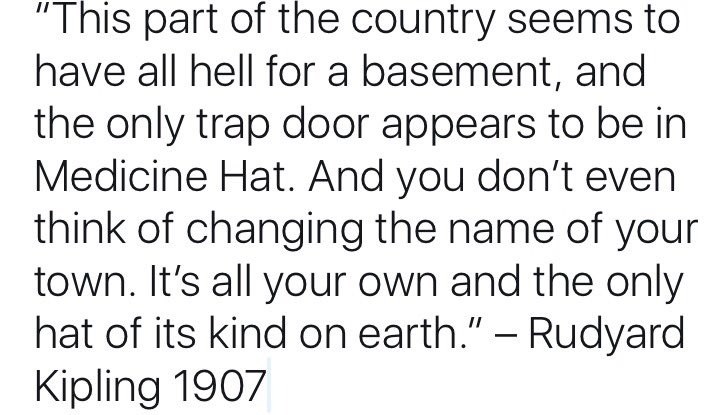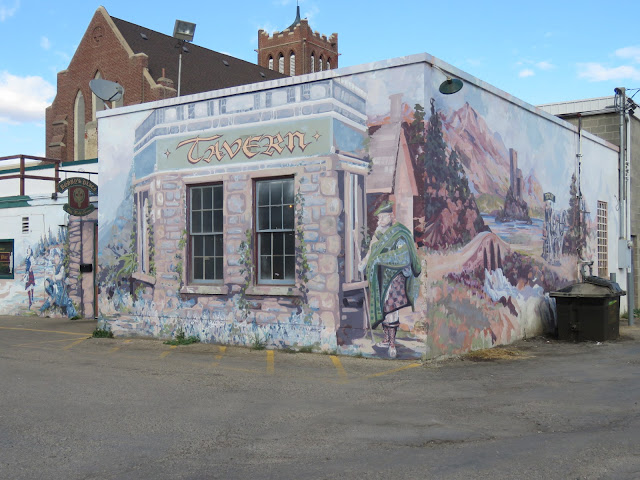September 2017
John has an oil change scheduled so it was 11 before we got going.
While I waited I remembered there was a connection between Medicine Hat and Kipling.
In the year 1910 Medicine Hat almost renamed itself Gasburg.
Whoever came up with this name obviously wasn't thinking about the fart jokes of the future, but rather the city's newfound natural gas industry.
According to Philip Pype, the archivist with the Esplanade Archives in Medicine Hat, the city dodged that bullet thanks to the author of the Jungle Book, Rudyard Kipling.
At the request of the residents, the British writer penned a convincing letter to the editor of the Medicine Hat News.
"He basically said that if such a place as Medicine Hat were to rename itself and turn its back on its own heritage and on its own values, it might as well rename it Judasville."
Ironically it was the city's Blackfoot name that lured the famous author to the boonies of the British Empire.
"He was actually intrigued by the name itself and received an invitation during his trip across North America. So, he came here by train, he and his wife, and took a tour of our city and became a big fan of Medicine Hat," said Pype.
Kipling wrote for Collier’s magazine in 1908, saying Medicine Hat is “The Town that was Born Lucky.”
A monument commemorating the efforts of local soldiers during World War I is taking shape on the side of Robertson Hill.
Project 175 is meant to recognize the Third Canadian Mounted Rifles and the 175th Infantry Battalion.
Two 40 foot maple leafs will flank either side of the lettering and use around 7,000 bricks donated from the old IXL brick plant in Redcliff. Many of the bricks date back over 100 years and took a team of volunteers 12 days to clean.
We go to Costco for some snacks and to their liquor outlet, taxes are so low in Alberta that single malt scotch is $20 cheaper than in Ontario.
This internationally-recognized monument, arguably Medicine Hat’s most prominent landmark, is known as the Saamis Teepee. Standing at 65.5 metres, the Saamis Teepee holds the record for being the tallest teepee in the world.
There will be a separate post on the teepee as it was beautiful.
Are those cows? No! Pull over!
We have marked this drive as the most boring day of the trip. Spotty radio reception as well.
AND Saskatchewan does not have any restrooms at their rest areas, seriously??
The land is so flat, the locals say if your dog ran away, it would be days before the wagging tail would disappear over the horizon.
The highway runs straight, not having to navigate around natural obstacles.
The recurring grain elevators here symbolize the vas agricultural capacity of this land, and are the larger-than-life milestones indicating towns alongside the railway.
As we appraoch Moose Jaw I google attractions and discovered that Moose Jaw is the mural capital of North America! Who knew?

The Moose Jaw City Hall is home to the Moose Jaw City Council an and is designated as a municipal heritage property. The building was originally designed and built by the J. McDiarmid Company for the Government of Canada to house a post office, Royal Canadian Mounted Police station and other government offices. In 1965 the building was sold by the federal government to the City of Moose Jaw and converted into a city hall.
Moose Jaw Police Service Headquarters is located in a building attached at the rear of the building.

The Land Titles Building was constructed in 1910 and until 1998, held the distinction of being the only one of eleven surviving Land Registry facilities in the province to maintain its original function. This building replaced a temporary Land Titles facility established here around 1907—a time when Moose Jaw and area were experiencing accelerated population and development growth. The building of a new Land Titles Registry was prompted by the rapid population growth that Moose Jaw experienced in the early part of the twentieth century. Moose Jaw’s reported population increased from 1,558 in 1901 and 6,249 in 1906, to 13,823 in 1911. This growth, together with its evolution into an important regional commercial and administrative centre justified and necessitated the establishment of this substantial Land Titles Building.

J.N. McDonald founded the Times as a weekly in 1889. One of its early owner-editors was Thomas Walter Scott in 1894-1895. Scott would later become the first Premier of Saskatchewan. The paper converted to a daily in 1906, changing its name to the Evening News; in 1920 it purchased its rival the Daily News and in 1923 established the Times Morning Herald, though this morning edition was discontinued a few years later.
In 1949, Roy Thomson purchased the Times-Herald. Thomson Newspapers published it until October 1995, when it was sold along with its sister papers the daily Prince Albert Daily Herald and the weekly Swift Current Booster to Hollinger Inc. Those three Saskatchewan papers were then sold to CanWest in 2000 and later to Montreal-based publisher Transcontinental in 2002. In May 2016, Transcontinental sold its 13 newspapers in Saskatchewan to Star News Publishing of Alberta.
As we appraoch Moose Jaw I google attractions and discovered that Moose Jaw is the mural capital of North America! Who knew?
The Moose Jaw City Hall is home to the Moose Jaw City Council an and is designated as a municipal heritage property. The building was originally designed and built by the J. McDiarmid Company for the Government of Canada to house a post office, Royal Canadian Mounted Police station and other government offices. In 1965 the building was sold by the federal government to the City of Moose Jaw and converted into a city hall.
Moose Jaw Police Service Headquarters is located in a building attached at the rear of the building.
J.N. McDonald founded the Times as a weekly in 1889. One of its early owner-editors was Thomas Walter Scott in 1894-1895. Scott would later become the first Premier of Saskatchewan. The paper converted to a daily in 1906, changing its name to the Evening News; in 1920 it purchased its rival the Daily News and in 1923 established the Times Morning Herald, though this morning edition was discontinued a few years later.
In 1949, Roy Thomson purchased the Times-Herald. Thomson Newspapers published it until October 1995, when it was sold along with its sister papers the daily Prince Albert Daily Herald and the weekly Swift Current Booster to Hollinger Inc. Those three Saskatchewan papers were then sold to CanWest in 2000 and later to Montreal-based publisher Transcontinental in 2002. In May 2016, Transcontinental sold its 13 newspapers in Saskatchewan to Star News Publishing of Alberta.
We come across Walter Scott in Regina.
Toronto has a Roy Thomson Hall - item to check out.
Weekly recap with more photos
Day 5 - Denver CO to Rapid City SD
The Curtis Hotel Denver CO funky themed floors
Day 6 - Rapid City SD Mount Rushmore City of Presidents
Day 7 - Rapid City SD to Billings MT Crazy Horse and Little Big Horn
Day 8 - Billings MT to Driggs ID
Day 9 - Jackson Hole WY and Grand Teton NP
Day 5 - Denver CO to Rapid City SD
The Curtis Hotel Denver CO funky themed floors
Day 6 - Rapid City SD Mount Rushmore City of Presidents
Day 7 - Rapid City SD to Billings MT Crazy Horse and Little Big Horn
Day 8 - Billings MT to Driggs ID
Day 9 - Jackson Hole WY and Grand Teton NP






































I think the classic car on the roof does it for me!
ReplyDeleteThe mural capital? Wow -- the mother lode! So cool you saw those buffalo. And, yes, the plains can be monotonous to drive through, but no bathrooms? That's crazy.
ReplyDelete